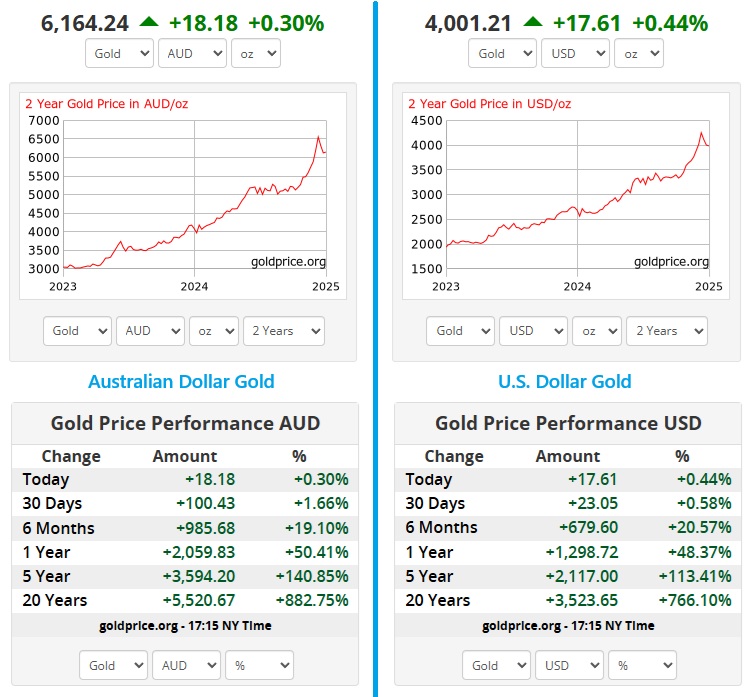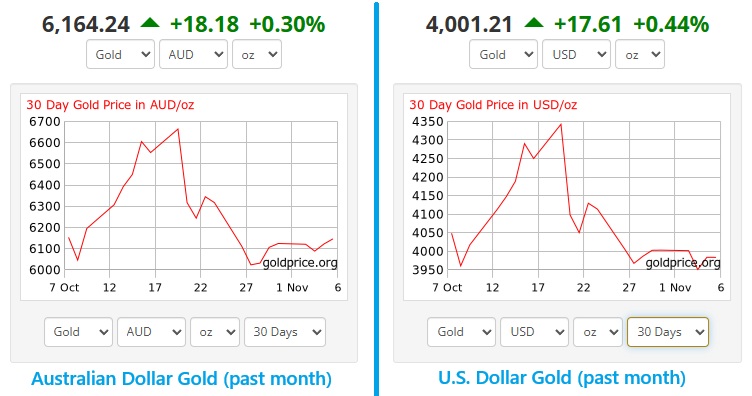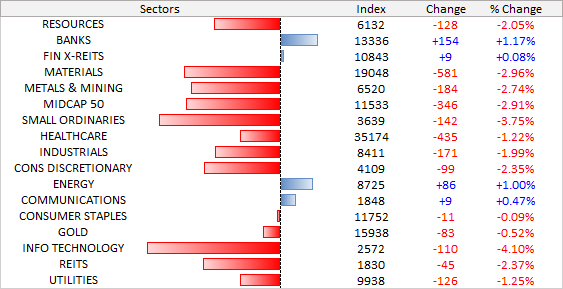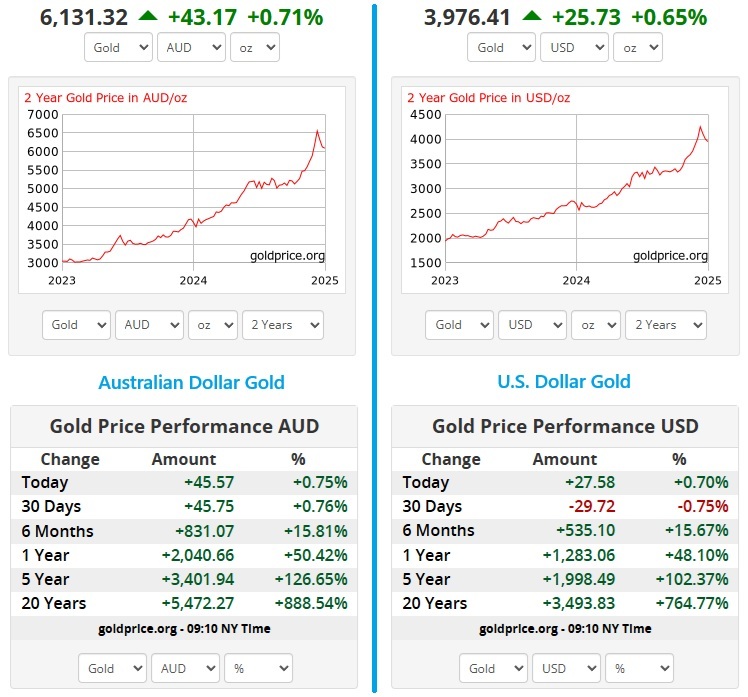Saturday 8th November 2025:
In today's weekly wrap email, Marcus Padley's MarcusToday team said: "Gold back over $4,000, up $17 overnight. Signs of it bottoming. It is 8.9% off the top."

Above are the two year charts that show the gold bull market that we're in; Below are the one month charts that show the little circa 10% correction that that we've just had within that longer term bull market.

Gold price charts sourced from: https://goldprice.org/
The A$ chart above suggests the correction might be over, however what I'm seeing on the one month US$ chart on the right suggests to me that gold is going sideways rather than rising again. Importantly however the A$ gold price remains over A$6,000/ounce and it's back above US$4,000/ounce now also, however only just, at US$4001/ounce. I believe we could have a period of consolidation (sideways movement) before the next leg up, but I fully expect another leg up, or 7. I just don't know when that will start.
My gold exposures are all via gold companies rather than physical gold, and my exposure is mostly to A$ gold, however the A$ gold price is just the US$ gold price converted to Australian Dollars so the US$ gold price is the fundamental driver of the A$ gold price, with the A$:US$ exchange rate being the other driver. I therefore watch both as they are both important.
For now it doesn't matter if they go sideways because current levels are very high for gold already, and I personally think that the chance of gold doubling again from here over the next 3 years is more likely than the gold price halving, just because of the main driver I discussed over the past few days, being accelerating lack of confidence in the US Dollar and US Treasuries - and of fiat currencies in general. So the perception that gold will hold its value better than fiat currencies like the US Dollar, and the likelihood that viewpoint will become even more widespread and popular than it is already in the near to mid-term.
That MT newsletter that I referred to at the top of this forum post also said this morning: "US Job numbers weren’t released last night thanks to the shutdown – watch for a ‘data dump’ when the shutdown ends (could cut either way)."
That's something to keep in mind, that the US Government shutdown, which is now officially the longest one ever, means that a lot of data that the market usually feeds off has been delayed, and when that data is all finally collated and released, which you'd expect will happen after the US Government shutdown ends and all of those public servants start to get paid again, is most likely going to cause some volatility, especially if it's all released at once and people are initially confused as to what datapoints are the most relevant and impactfull.
Something that might impact the Government shutdown is that Democrats are currently celebrating after posting sweeping victories across several high-profile contests in the nation’s first major elections since President Donald Trump’s return to the White House - see here: https://www.newsweek.com/full-list-democrat-victories-upsets-nationwide-10994750 and here: BBC: Democrats hit back and a winning message - four election night takeaways
Both of those stories are three days old, so Tuesday night their time or Wednesday our time.
The MT weekly wrap newsletter email this morning said: "SPI Futures up 23. Hopes for a shutdown solution saw US markets bounce off their lows, although election wins are emboldening the Democrats' resolve not to deal."
Also, later in that email: "Details were scarce but involved Democrats offering to scale back their Health Care demands from a permanent extension of Affordable Care Act subsidies to a one-year extension. Republicans rejected the attempt at negotiation but said it indicated ‘progress’. Pressure to resolve the impasse keeps building. Transport Secretary warned airlines could be forced to cut 20% of flights if no resolution is made.
Still no government economic news (payrolls report had been scheduled for last night) but Michigan consumer sentiment fell to its lowest level in three years. Down 30% since Trump took office. The reading of 50.3 was the second lowest on record. Driven by concerns over the government shutdown and reinforced the K-shaped economy narrative (high income households doing well, lower income struggling). Inflation expectations fell from 3.9% to 3.6%. Despite more positive US earnings the Nasdaq had its worst week since the Tariff Tumble. Down 3%. Path of least resistance lower as Big Tech valuation concerns outweighed positive momentum from the swath of good news in the previous week. S&P 500 -1.63% vs ASX down 1.26%. Bond yields quiet. USD down."
Interestingly while many people seem to think the Aussie gold sector is still falling, it was nowhere near the worst sector over the past week, in fact gold was only down half of 1% (-0.52%) this past week:

Above = Aussie sector movements this past week; source: Marcus Padley's MarcusToday weekly wrap newsletter email this morning.
So after being smashed the previous week, the Aussie gold sector actually outperformed most other sectors in the past week.
Either the continuation of the US government shutdown or the data dump that results from the resolution of the shutdown (resumption of US government) should provide further volatility which is generally a positive for gold. But I'm not making any short term predictions. Longer term, gold is going higher IMO, but that's just my opinion.
Further reading on gold companies at the early and much more speculative stage: https://strawman.com/forums/topic/12184#post-39649 [TCG - Turaco Gold - and a discussion of what I'm researching and looking for at the smaller, speculative end of the sector].
Wednesday 5th November 2025:
https://www.youtube.com/watch?v=l-8aDiR5UtM
SHOW NOTES:
We’re mixing it up today with a different kind of episode featuring a Money of Mine favourite, Sean Russo.
Sean’s a fountain of market & mining knowledge, and we tap into it to uncover:
- What history teaches us about how to play gold
- The key ratios that really matter – and what they’re screaming right now
- The global forces driving gold higher
- Plus, plenty more insight, stories and sharp takes from one of the industry’s best.
This was recorded on 4.11.2025.
CHAPTER TIMESTAMPS
00:00 Gold's Greatest Irony
03:55 When Gold Goes Mainstream
07:00 Charts: Where Technical Analysis Meets Human Psychology
09:52 The Unknown Unknowns: Why Charts Trump Narratives in Gold Trading
13:13 Tales of the Ultra-Wealthy's Metal Fetish
19:00 Asia's Love Affair with Gold
23:59 How the World's Smartest Investors Secretly Hate Gold
28:01 Gold Miners Hoarding Gold: The Dumbest Smart Idea in Mining
32:11 Bitcoin vs Gold: 50 Years of Fiat Currency's Greatest Hits
37:37 Hong Kong's Payday Effect: When Locals Taught Traders About Real Money
42:23 The Hunt Brothers' Silver Squeeze: Why Markets Take a Decade to Forget
47:05 Mining's Identity Crisis: From Unloved Sector to National Security Priority
51:37 The Revenge of High-Vis: Why Remote Work Can't Mine Copper
55:44 Index Inclusion: The Corporate World's Most Expensive Beauty Contest
1:00:09 The Art of Hedging
Source: https://www.youtube.com/@MoneyofMine

Source: https://goldprice.org/
Aussie Gold still over $6000/ounce.

Sunday 2nd November 2025:

Plenty on GG8 (Gorilla Gold Mines), their September quarter report, and on reading and interpreting diagrams and drill hole results in gold company reports, and more, here: https://strawman.com/forums/topic/12176
Onward and upward.

@bear thanks for the afternoon Wednesday update the bearish traders certainly created a sea of red.
still the tail wind for the optimists with the countries such as China buying solid assets and shoring up the sovereign risk in these uncertain global events. The price per 0z should make any goldie a winner ...Time to top up opportunistic buying today.
The bears would be saying this is the pivot of the bubble .. maybe is... see how the Au trades over the next 3 days!!



